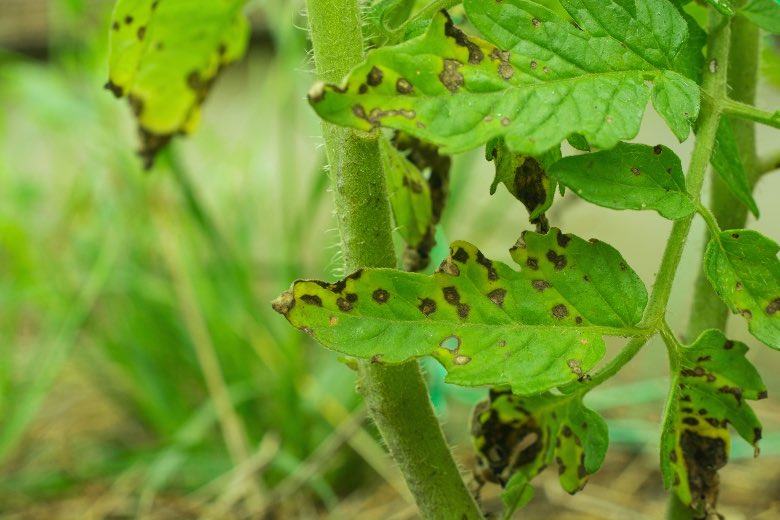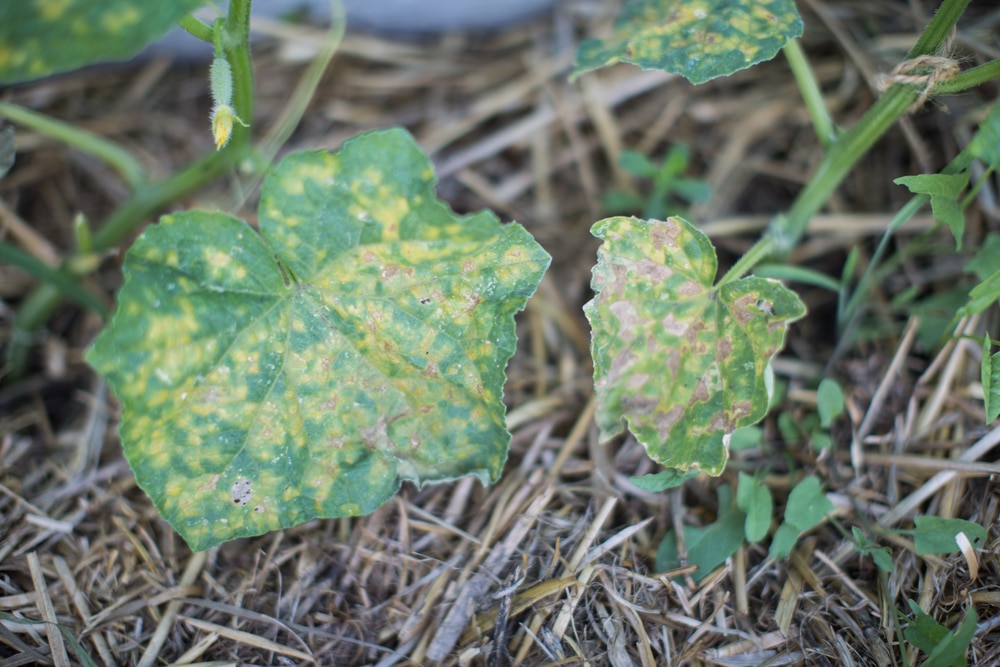As a plant parent, noticing unusual spots, splotches, or speckles on your plant’s leaves can give you pause. Small yellow spots often indicate an underlying issue that needs addressing. However, not all leaf spots spell trouble for your plants. By understanding the various causes of yellow spots, you can evaluate the situation and take appropriate action.
Common Causes of Yellow Spots
Small yellow spots can appear on leaves for many reasons Here are some of the most frequent culprits
-
Sun scorch – Intense sunlight burns leaf tissue, creating small pale yellow or brown dead spots Typically affects older leaves.
-
Nutrient deficiencies – Lack of key nutrients like nitrogen, iron, magnesium, or zinc leads to yellowing between leaf veins or yellow spotting.
-
Fungal diseases – Fungal leaf spot diseases produce yellowing lesions or patches, often with defined edges. Powdery mildew can coat leaves in yellow fuzzy growth.
-
Pests – Insects like thrips and mites feed on leaf undersides, causing yellow stippling or spots. Also leads to bronzing or browning.
-
Water stress – Too much or too little water results in yellow spotting, marginal scorching, or overall chlorosis.
-
Chemical leaf scorch – Over-fertilizing or using too much pesticide damages leaf tissue, creating brown/yellow spotting.
-
Bacterial diseases – Bacteria like Xanthomonas cause yellow, water-soaked spots that expand into large lesions.
-
Viral infections – Viruses produce yellow mosaic patterns, ringspots, mottling, and line patterns on leaves.
Evaluating Yellow Leaf Spots
Noticing a few tiny yellow spots on your plant leaves isn’t necessarily a major concern. But if spots are numerous, expanding, or accompanied by other symptoms, it likely indicates a problem needing attention. Follow these tips to evaluate the situation:
-
Check if spots are isolated or widespread on the plant,
-
Note if spots are concentrated on older or newer leaves. This provides clues to the cause.
-
Look for patterns like random spotting, spots along veins, defined edges, etc.
-
Inspect undersides of leaves closely using a magnifying glass to detect fungi or pests.
-
Consider recent weather conditions and cultural practices that could be impacting the plant.
-
Rule out causes like sun scorch and chemical damage before assuming disease or pests.
-
Compare spots to reference guides or photos to ID the likely culprit.
-
Remove and isolate affected plants if spots are rapidly worsening.
Managing Key Causes of Yellow Leaf Spots
Once you’ve identified the probable cause, you can take action to manage the issue:
-
For sun scorch, increase shade, prune affected leaves or move the plant. It cannot be cured but is preventable.
-
Nutrient deficiencies can be corrected by applying suitable fertilizers containing the lacking nutrients.
-
Fungal diseases may be treated with fungicides or by improving air circulation and watering practices.
-
Insects can be controlled through contact insecticides, insecticidal soaps, or by spraying off pests with water.
-
Fix watering issues and drought stress by adjusting irrigation practices.
-
Avoid chemical leaf scorch by not over-applying fertilizer or pesticides.
-
For bacterial diseases, prune affected leaves, disinfect tools, and space plants properly.
-
Viral infections cannot be cured so isolate and remove infected plants to prevent spreading.
When to Worry About Yellow Spots
As a general rule, small yellow spots are not an emergency unless they are rapidly worsening or accompanied by other alarming symptoms like:
-
Expanding spot size
-
Large numbers of spots
-
Spots combining into large affected areas
-
Distorted leaf shape or curling leaves
-
Visible fungal growth, insects, or excrement
-
Wilting, drooping, or dying leaves
-
Stunted growth
-
Plant decline or failure to thrive
If you observe any combination of these warning signs, take prompt action to diagnose and treat the problem, or remove and destroy affected plants if necessary to prevent spreading.
When caught early, minor yellow leaf spotting can often be managed and resolved. But at the first sign of distress, give your plant a thorough inspection and address any issues found right away. Paying close attention and providing proper care will keep your plant’s foliage healthy, vigorous, and spot-free.
When to Seek Expert Advice
If you are unsure about the cause of yellow leaf spots or need help developing an action plan, don’t hesitate to consult a horticultural specialist. Local county extension offices, universities, and professional plant diagnostic clinics can assist with identifying the issue through microscopic analysis, lab culture, or DNA/RNA testing. They can also provide science-based treatment recommendations for your situation. Investing in an expert diagnosis can help you get the bottom of persistent plant problems.
With attentive observation skills and prompt troubleshooting, those small yellow spots are no match for your dedication as a plant parent! Just remember to act at the first sign of distress, and your green friends will thrive under your careful watch.
Causes and solutions of leaf septoria, a very common disease that stains the leaves of plants yellow
The plants’ leaves have yellow spots that clearly show they have a fungal disease called leaf septoria or just Septoria.
Tomato and cannabis plants are the ones most affected. And imagine how sad it must be for people who plant marijuana seeds and care for seedlings all the way through to see yellow spots on the leaves.
Today, we’re going to tell you how to treat this plant disease and keep the yellow spots on the leaves from coming back.
You can use our tips on any plant, but be careful with marijuana. In the UK, planting cannabis seeds is either a civil or a criminal offense, so we don’t think you should start doing this.
- AUTOMATICQuantityx2 x4 x7 x12Rated 4. 78 out of 5 based on 49 customer ratings(49).
- FEMINIZEDQuantityx2 x4 x7 x12Rated 4. 56 out of 5 based on 48 customer ratings(48).
- FAST FLOWERINGQuantityx2 x4 x7 x12 x14Rated 4. 80 out of 5 based on 51 customer ratings(51).
- KITRated 4.71 out of 5 based on 52 customer ratings(52)
In countries that don’t have the same rules as the UK, you can buy auto flowering seeds, feminized seeds, and fast flowering weed seeds to collect or grow.
And now, let’s focus on leaf septoria and remedies for this particular disease.
Leaf septoria: the cause of yellow spots on lemon leaves, tomatoes and many other plants
When the leaves turn yellow, the spots are probably caused by a Septoria type of fungus. Most of the time, Septoria lycopersici does the damage to plants, but Septoria neocannabina or Septoria cannabis does as well.
Cannabis and many other plants, like lemons and tomatoes, get this fungal disease, which makes the whole plant weaker.
Leaf septoria has very clear symptoms, but the fungus mostly affects the oldest leaves, which are lower on the plant. Here are what symptoms we talk about:
- Round spots on the leaves that change from white to yellow to brown and look like small sores
- In the later stages, the sores on the leaves start to look like lumps.
- As time goes on, the lumps get bigger and quickly cover all the leaves.
- The affected leaves dry out and fall off.

The plantation doesn’t die from this disease, but it radically cuts down on flowering and, by extension, the harvest. It is, therefore, essential that farmers take the necessary measures to block the spread of Septoria.
So, it’s not just a matter of looks; the yellow spots on the leaves are a sign of a disease that needs to be stopped right away by first looking into what caused it.
How To Identify & Prevent Leaf Spot Disease or Leaf Septoria – Cannabis Plants
What causes yellow spots on leaves?
Yellow spots on leaves could also be an indicator of nutrient deficiencies. Essential minerals like nitrogen, iron, or magnesium are crucial for the overall health of plants. When these are lacking, yellow spots can appear on the leaves. Deficiencies could be due to poor soil conditions or improper fertilization.
Why is pus green or brownish yellow?
Pus is a thick, opaque fluid that oozes out from the wound, and is formed from dead white blood cells, debris, and antibodies that fight against the infection. Usually, it will be white or light yellowish. Green discoloration of the pus indicates an infection from Pseudomonas bacterial infection. The brown discoloration is seen in liver infection or collection of dead neutrophils in the pus. Yellow discoloration suggests infection from staphylococcus bacterial infection. The color of the pus would indicate the type of infection and thus help in starting the appropriate treatment.
How do you know if a plant has yellow spots?
These spots may start off small and gradually spread over time if left untreated. As yellow spots progress, you may notice certain physical changes in the affected leaves. These changes can include wilting, curling, or browning of the leaves. Additionally, the affected areas may become brittle and easily break off from the plant.
What does yellowing of leaves mean?
Yellowing of the leaves can also indicate that the soil is lacking other nutrients such as iron, manganese, or zinc. While the pattern of how the yellowing of the foliage progresses can give a trained eye some clues to which nutrient might be lacking, the most reliable way is to do a soil test.
- The Ultimate Guide to Growing Strawberries in Raised Beds - August 8, 2025
- No-Dig Garden Beds: The Easiest Way to Grow a Beautiful Garden - August 6, 2025
- How to Protect and Preserve Wood for Raised Garden Beds - August 6, 2025

